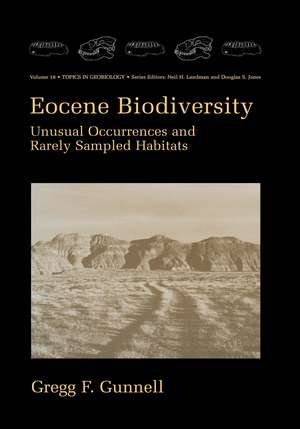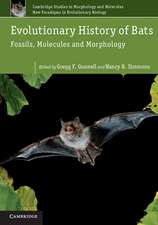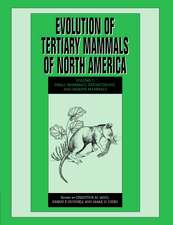Eocene Biodiversity: Unusual Occurrences and Rarely Sampled Habitats: Topics in Geobiology, cartea 18
Editat de Gregg F. Gunnellen Limba Engleză Paperback – 24 sep 2012
This book is conceived as an introduction to non-traditional Eocene fossils samples, and as a place to document and discuss features of these fossil assemblages that are rare or that come from rarely represented habitats.
| Toate formatele și edițiile | Preț | Express |
|---|---|---|
| Paperback (1) | 952.54 lei 43-57 zile | |
| Springer Us – 24 sep 2012 | 952.54 lei 43-57 zile | |
| Hardback (1) | 967.56 lei 43-57 zile | |
| Springer Us – 30 sep 2001 | 967.56 lei 43-57 zile |
Din seria Topics in Geobiology
- 18%
 Preț: 1858.10 lei
Preț: 1858.10 lei - 20%
 Preț: 822.09 lei
Preț: 822.09 lei - 15%
 Preț: 672.43 lei
Preț: 672.43 lei - 18%
 Preț: 1236.82 lei
Preț: 1236.82 lei - 15%
 Preț: 647.59 lei
Preț: 647.59 lei - 24%
 Preț: 885.06 lei
Preț: 885.06 lei - 18%
 Preț: 951.59 lei
Preț: 951.59 lei - 18%
 Preț: 964.23 lei
Preț: 964.23 lei - 18%
 Preț: 1117.69 lei
Preț: 1117.69 lei - 15%
 Preț: 633.31 lei
Preț: 633.31 lei - 18%
 Preț: 966.27 lei
Preț: 966.27 lei - 18%
 Preț: 949.85 lei
Preț: 949.85 lei - 18%
 Preț: 1013.50 lei
Preț: 1013.50 lei - 24%
 Preț: 821.19 lei
Preț: 821.19 lei - 18%
 Preț: 952.40 lei
Preț: 952.40 lei - 18%
 Preț: 961.23 lei
Preț: 961.23 lei - 18%
 Preț: 952.26 lei
Preț: 952.26 lei - 18%
 Preț: 960.42 lei
Preț: 960.42 lei - 18%
 Preț: 1843.11 lei
Preț: 1843.11 lei - 18%
 Preț: 954.31 lei
Preț: 954.31 lei - 18%
 Preț: 1256.41 lei
Preț: 1256.41 lei - 18%
 Preț: 959.50 lei
Preț: 959.50 lei - 15%
 Preț: 673.60 lei
Preț: 673.60 lei - 18%
 Preț: 954.14 lei
Preț: 954.14 lei - 15%
 Preț: 640.06 lei
Preț: 640.06 lei - 18%
 Preț: 959.36 lei
Preț: 959.36 lei
Preț: 952.54 lei
Preț vechi: 1161.64 lei
-18% Nou
Puncte Express: 1429
Preț estimativ în valută:
182.33€ • 198.11$ • 153.25£
182.33€ • 198.11$ • 153.25£
Carte tipărită la comandă
Livrare economică 21 aprilie-05 mai
Preluare comenzi: 021 569.72.76
Specificații
ISBN-13: 9781461354710
ISBN-10: 1461354714
Pagini: 468
Ilustrații: XXI, 442 p.
Dimensiuni: 178 x 254 x 25 mm
Greutate: 0.8 kg
Ediția:Softcover reprint of the original 1st ed. 2001
Editura: Springer Us
Colecția Springer
Seria Topics in Geobiology
Locul publicării:New York, NY, United States
ISBN-10: 1461354714
Pagini: 468
Ilustrații: XXI, 442 p.
Dimensiuni: 178 x 254 x 25 mm
Greutate: 0.8 kg
Ediția:Softcover reprint of the original 1st ed. 2001
Editura: Springer Us
Colecția Springer
Seria Topics in Geobiology
Locul publicării:New York, NY, United States
Public țintă
ResearchCuprins
1 • An Updated Review of the Fish Faunas From the Green River Formation, the World’s Most Productive Freshwater Lagerstätten.- 1. Introduction.- 2. The Green River System as a Paleogene Great Lakes Complex.- 3. An Updated Look at the Taxonomic Diversity of the Green River Fish Faunas.- 4. Summary of Inter-Lake Faunal Comparisons.- 5. Comment on the Biodiversity of the Green River Fish Fauna.- 6. Future Studies.- References.- 2 • Paleontological Investigations at the Eocene Locality of Mahenge in North-Central Tanzania, East Africa.- 1. Introduction.- 2. History of Paleontological Research.- 3. Research Area and Geological Context.- 4. Stratigraphy.- 5. Lake Paleoecology.- 6. Age of the Fossil Beds.- 7. Renewed Fieldwork at Mahenge.- 8. Other Localities in the Singida Area.- 9. The Mahenge Fauna and Flora.- 10. Discussion and Conclusions.- References.- 3 • Early Wasatchian Mammals From the Gulf Coastal Plain of Mississippi: Biostratigraphic and Paleobiogeographic Implications.- 1. Introduction.- 2. The Mammalian Component of the Red Hot Local Fauna.- 3. Discussion.- 4. Summary.- References.- 4 • Paleocene-Eocene Microvertebrates in Freshwater Limestones of the Willwood Formation, Clarks Fork Basin, Wyoming.- 1. Introduction.- 2. Geology.- 3. Fauna.- 4. Depositional Environment.- 5. Contribution of Limestone Fauna.- 6. Summary.- References.- 5 • Unusual Vertebrate Microfaunas From the Willwood Formation, Early Eocene of the Bighorn Basin, Wyoming.- 1. Introduction.- 2. Materials and Methods.- 3. Synopsis of Quarry Sites.- 4. Taphonomy.- 5. Compositional Comparisons.- 6. Future Work.- 7. Conclusions.- References.- 6 • Stratigraphy and Taphonomy of Grizzly Buttes, Bridger Formation, and the Middle Eocene of Wyoming.- 1. Introduction.- 2. Geology.- 3.Taphonomy.- 4. Notharctid Primates.- References.- 7 • Taphonomic Analysis of the Messel Formation (Germany).- 1. Introduction.- 2. Messel Vertebrates.- 3. Geology and Paleoclimate.- 4. Taphonomy.- References.- 8 • Paleobiological Implications of the Messel Mammalian Assemblage.- 1. Introduction.- 2. Small Omnivorous-Insectivorous Forest Floor Dwellers.- 3. Aerial Insectivory.- 4. Arboreal Life.- 5. Reproduction and Ontogeny.- References.- 9 • The Eocene Mammalian Fauna of Chambi (Tunisia) in Its Geological Context.- 1. Introduction.- 2. Paleogeography and Biostratigraphy.- 3. Continental Paleogene Series.- 4. Summary of Chambi Vertebrates.- References.- 10 • Gandhera Quarry, A Unique Mammalian Faunal Assemblage From the Early Eocene of Baluchistan (Pakistan).- 1. Introduction.- 2. Geologic Setting.- 3. Collecting Techniques.- 4. Taxonomic Composition.- 5. Bones at Gandhera Quarry.- 6. Summary.- References.- 11 • Paleoecology and Biostratigraphy of Marginal Marine Gulf Coast Eocene Vertebrate Localities.- 1. Introduction.- 2. Wilcox Group.- 3. Claiborne Group.- 4. Barnwell Group.- 5. Jackson Group.- 6. Discussion.- References.- 12 • Taphonomic Interpretation of Gnat-Out-of-Hell, an Early Uintan Small Mammal Locality in the Uinta Formation, Utah.- 1. Introduction.- 2. Taphonomy of Predator Assemblages.- 3. Methods.- 4. Results.- 5. Discussion.- References.- 13 • A Mass Death Accumulation of Coryphodon anthracoideus (Mammalia: Pantodonta) at Roehler’s Coryphodon Catastrophe Quarry (Lower Eocene, Wasatch Formation), Washakie Basin, Wyoming.- 1. Introduction.- 2. Regional Geology and Paleontology.- 3. Taphonomy.- 4. Conclusion.- References.- 14 • Meniscotherium Mass-Death Assemblages.- 1. Introduction.- 2. Ucmp Locality V71237.- 3. Nmmnh Locality L-201.-4. Nmmnh Locality L-203.- 5. Discussion.- 6. Associated Faunas.- 7. Population Samples of Meniscotherium.- 8. Summary.- References.- Appendix 1.- Appendix 2.- Appendix 3.- 15 • Taphonomy, Fauna, and Depositional Environment of the Omomys Quarry, an Unusual Accumulation From the Bridger Formation (Middle Eocene) of Southwestern Wyoming (USA).- Abstract.- 1. Introduction.- 2. Materials and Methods.- 3. Geology.- 4. The Omomys Quarry Fossil Assemblage.- 5. Taphonomy of the Omomys Quarry.- 6. Conclusions.- References.- 16 • Basin Margins, Biodiversity, Evolutionary Innovation, and the Origin of New Taxa.- 1. Introduction.- 2. Geology of South Pass, Wyoming.- 3. The Bridgerian Land Mammal Age.- 4. Basin Margins.- 5. Recognition of Ancient Basin Margin Environments.- 6. Basin Margin Faunas.- 7. Anachronism and Cladogensis.- 8. Speciation.- 9. Conclusions.- References.
Recenzii
`The papers in this volume are of consistently high quality and each will be a valuable contribution to the field. I highly recommend this book to anyone interested in the Ecocene specifically of the history of global biodiversity through geologic time.'
Quarterly Review of Biology, 77:4 (2002)
Quarterly Review of Biology, 77:4 (2002)













